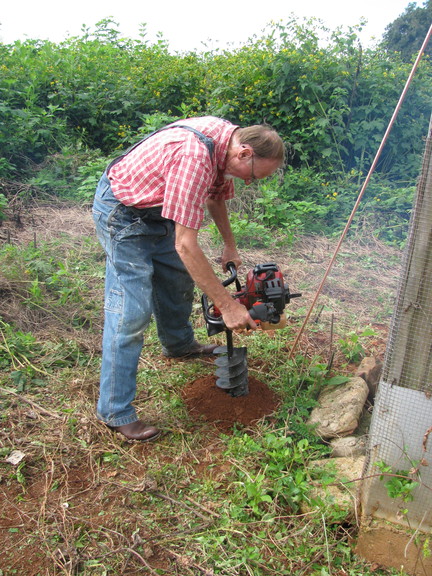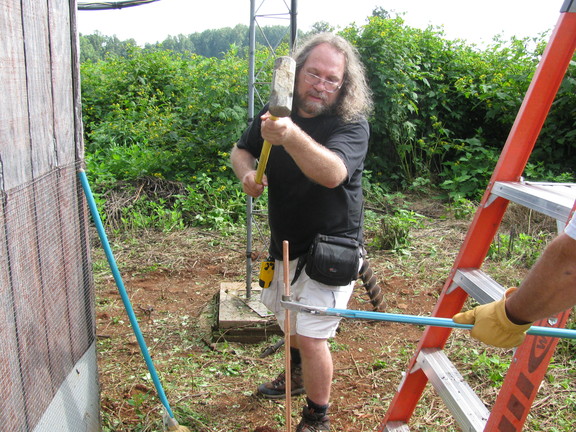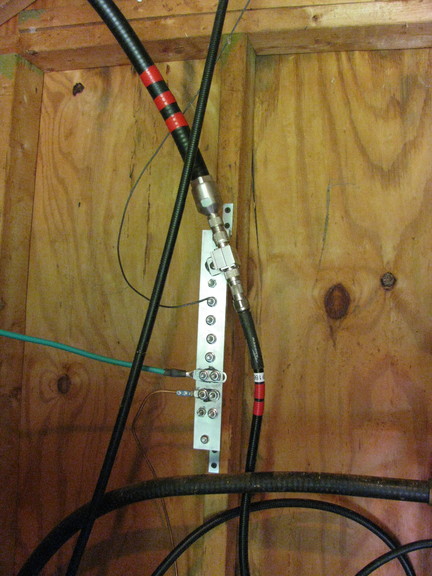
Al KF4AGT drilling hole for Flamini ground rod
to be filled with bentonite clay and epson salts
Photo: Mark Whitis AK4OL
CC-BY-3.0-US
The configuration on the WA4TFZ 146.760Mhz repeater has been changed today so that, while you still need to send 151.4Hz CTCSS, the repeater does not send CTCSS. Some CTCSS does appear to leak through from the transmitting station but your radio is likely to not reliably stay unsquelched during reception if your radio is set to require CTCSS inbound. For chirp and many radios, this means the radio needs to be set to “TONE” instead of “Tone Sqeulch” or “TSQL” or something similar. My radio was squelching about half the time. Also, you won’t hear the courtesy beep as there is no CTCSS from the transmitter to leak through.
This change was made as a temporary (weeks, months) measure since it is believed that 151.4 from the transmitter side was feeding through into the receive side and causing the repeater to rebroadcast large amounts of noise.
Bill Pond, N0WP, posted the following about our latest safari trip:
Just wanted to update everyone on some work that was done today at Marshall Manor, and one interesting item we discovered after we left.
Today, Mark, AK4OL, Al, KF4AGT, Mike, KQ9P and myself made a trip to the Marshall Manor site i.e.: snake pit. Al was again generous to provide our 4WD safari coach. Our primary objective was to improve our grounding to an acceptable level which I think we did by installing a “Flamini ground” and establishing a new ground bus in the shack grounding the 2 meter polyphaser and repeater rack. We also extended this same run from the new ground rod to the tower. We also replaced some existing poor ground connections. We seem to always make steps forward but upon doing this, we find other items needing attention. We noted there is no polyphaser on the 440 antenna run, so this will be work to accomplish on the next visit. Thanks to George Grotz for very generously providing us some #6 copper ground wire and various termination fittings, saving the club quite a bit of money in the process as we improved the site grounding. We did some more work on the new 440 repeater audio, and re-inserted the 440 receiver pre-amp. I hope we’re close to having that audio up to snuff.
Other work done involved a change to the CTCSS configuration of both repeaters which helped us identify another issue on the 146.760 machine that still needs attention. During some of the prior trips, we had learned that some of the noises we keep getting were related to the outgoing 151.4 tone somehow finding it’s way back to the input, being decoded, and helping to create some of these noises. Today, we turned OFF the outgoing 151.4 tone from both the 146.760 and 444.00 repeater transmitters. This means that users should now use carrier squelch on their rigs, and not use CTCSS squelch. You will still need to SEND 151.4 to key the repeater, but you should NOT use the tone previously generated by the repeater transmitter to unsquelch your receiver. On my Kenwood radios that means I now should use “T” and not “CT”. Other radios will of course be configured as needed. I’m aware this will now mean we might occasionally hear Williamsburg, but hopefully the day to day function of the repeater should now be better. This could be a temporary test, but it’s a test that we really felt was important in helping us work on the daily noise we’ve been experiencing.
NOW, the confusing issue that we discovered as we were leaving the site and traveling home. Mark first noticed that he had his radio configured for tone squelch, and he was able to still hear “most” of my transmissions, but all of another stations. Since the repeater was configured for no outgoing tone, this made no sense to me. He suggested what must be happening was that the CTCSS tone from the user was finding its way through the controller, and being retransmitted by the repeater transmitter. Logically this should not happen since the tone squelch board is in the audio path, and is supposed to remove any audio below approximately 250 Hz. AFTER the incoming audio is analyzed for CTCSS. So thinking about this, it appears this high pass filter is not properly functioning, and passing those low frequency components. Since different user radios encode CTCSS at different levels, this explains why some users were able to be heard “better” than others IF their radio was set to tone squelch. If a users radio was (properly) set for carrier squelch, no issues were heard. The key is that a user using tone squelch will hear MOST of the other stations audio, but will NOT hear courtesy tones.
I know this is confusing, and hopefully I haven’t lost you yet……. The key is for your radio to SEND CTCSS tones, but not require you to hear CTCSS tones to open your squelch.
I will replace the tone board on our next (hopefully soon) visit and make sure the audio high pass filter is working properly. This should make operations more consistent and eliminate this incorrect behavior. Hopefully we’ll soon have the club’s new service monitor available soon to make sure this issue is correctly resolved. It’s totally possible that some of our past strange behaviors have been related to the two CTCSS tones mixing.
Thanks again to Al, Mike, and Mark. It was a hot and dirty day up there today. We proved the “snake relocation tool” we purchased was worth it’s weight in gold, and we did accomplish a huge amount of needed work.
Please let me know if you have any questions on any of the above.
73,
Bill N0WP
Mark AK4OL driving ground rod, as did Al KF4AGT and Mike KQ9P. The snake stick costs a lot less to replace than a hand (Photo: AK4OL/KF4AGT):

Bill N0WP’s new custom fabricated ground bus bar (Photo: AK4OL):

